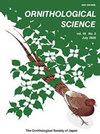Adaptive Features of the Eye to the Ecological Habit of the Short-Eared Owl Asio flammeus and Japanese Scops Owl Otus semitorques
IF 0.3
4区 生物学
Q4 ORNITHOLOGY
引用次数: 0
Abstract
Abstract In this study we investigated the eye morphology and retinal topography of two owl species in relation to their visual environment. Although Short-eared Owl Asio flammeus is larger and weighs more than Japanese Scops Owl Otus semitorques, its eye dimensions (weight, corneal diameter, and axial length) are all smaller than the scops owl's. Owl retinas were examined in Nissl-stained whole-mount preparations. The total number of retinal ganglion cells (RGCs) was greater in the Japanese Scops Owl (4,703.0×103 cells) than in the Short-eared Owl (2,346.8×103 cells). The eye morphology of, and the number of RGCs in the Japanese Scops Owl indicate that it is more adapted to a nocturnal habit. An area of high-density RGCs was horizontally distributed in the temporal retina of the Short-eared Owl, with a peak density of 17.4×103 cells/mm2. In the Japanese Scops Owl's temporal retina, there was an oval-shaped arrangement with a peak density of 23.1×103 cells/mm2. These distributions indicate that whereas Short-eared Owl is adapted to open habitats, Japanese Scops Owl is adapted to enclosed habitats. The RGCs of both species were classified into three categories (small, medium, and large) based on the size and appearance of somas. In both species, medium-sized cells predominated, and the proportion of large-sized cells was smallest. The distribution and high-density areas differed among these groups, suggesting adaptation to the visual environment. The high-density areas of these groups cover the nasal visual fields, which include the overlap for binocular vision.短耳鸮(Asio flammeus)和日本鸮(Otus semiorques)眼睛对生态习性的适应特征
摘要在这项研究中,我们研究了两种猫头鹰的眼睛形态和视网膜地形与它们的视觉环境的关系。虽然短耳猫头鹰Asio flammeus比日本Scops猫头鹰Otus semitorques更大、更重,但它的眼睛尺寸(重量、角膜直径和轴长)都比Scops猫头鹰的小。在Nissl染色的全支架制剂中检查猫头鹰视网膜。日本Scops Owl的视网膜神经节细胞总数(4703.0×103个细胞)大于短耳猫头鹰(2346.8×103个)。日本Scops Owl的眼睛形态和RGCs的数量表明它更适合夜间活动。短耳猫头鹰的颞叶视网膜中水平分布着一个高密度RGCs区域,峰值密度为17.4×103个细胞/mm2。日本Scops Owl颞叶视网膜呈椭圆形排列,峰值密度为23.1×103个细胞/mm2。这些分布表明,短耳猫头鹰适应开放的栖息地,而日本Scops Owl适应封闭的栖息地。根据胞体的大小和外观,这两个物种的RGCs被分为三类(小型、中型和大型)。在这两个物种中,中型细胞占主导地位,大型细胞的比例最小。这些群体的分布和高密度区域不同,这表明他们适应了视觉环境。这些组的高密度区域覆盖了鼻腔视野,其中包括双眼视觉的重叠。
本文章由计算机程序翻译,如有差异,请以英文原文为准。
求助全文
约1分钟内获得全文
求助全文
来源期刊

Ornithological Science
ORNITHOLOGY-
CiteScore
1.20
自引率
0.00%
发文量
26
审稿时长
>12 weeks
期刊介绍:
Ornithological Science publishes reviews, original articles, short communications and comments covering all aspects of ornithology. Manuscripts are judged on the basis of their contribution of original data and ideas or interpretation. All articles are peer-reviewed by at least two researchers expert in the field of the submitted paper. Manuscript are edited where necessary for clarify and economy. Ornithological Science aims to publish as rapidly as is consistent with the requirements of peer-review and normal publishing constraints.
 求助内容:
求助内容: 应助结果提醒方式:
应助结果提醒方式:


